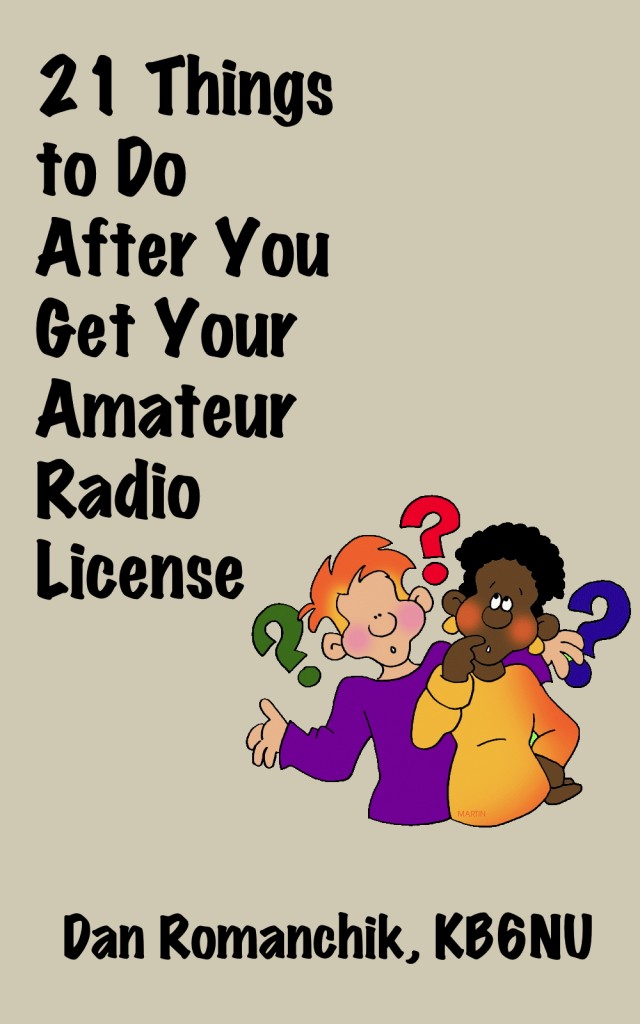
Dan Romanchik KB6NU has an ebook called 21 Things to Do After You Get Your Amateur Radio License. I ran across his blog while searching after one of the things I’ve been tracking down (building an antenna I think). I encourage you to buy his book if you like what you see here. I’ve been using his post (not his book yet) as a guide for things I might be interested in.
Already Done
Here are the things from KB6NU’s list that I’ve already done.
Buy some tools
This was one that I started with right away. I have some funds from my job to buy equipment and supplies and I made use of that to get a soldering iron, solder, de-soldering wick, flush cutting pliers and chain nose pliers. These were the first things that seemed like they would help me on my long term goal of building a Softrock SDR receiver (and transmitter?)
Buy a radio
This is easier now than ever before. Recent Chinese handheld, dual-band VHF/UHF radios have received very good reviews for function. The primary concern is the difficulty of programming the memories on the radio from the keypad. But open source software to the rescue: CHIRP is cross-platform radio programming software for handheld radios. I bought a Baofeng UV-5R from Amazon and I made sure to buy the programming cable off of eBay (e.g. : this one).
Since I got the radio, I’ve had no problems with getting it programmed for my local repeaters, even to the point of re-programming it when I went to visit San Diego with the repeaters in that area. I love the radio and I love the fact that I could buy it very reasonably and get on the air.
Get on the air
Buying a radio led naturally to getting on the air. It did take me a while to get up the courage to press the Push-To-Talk button and say my call, but I finally did while on my trip in San Diego (thanks NC7V!). Since then I’ve been able to get on the weekly ARES traffic nets on our local repeaters. Now I’m planning for a medium-term goal of getting on the air on HF as well.
Buy a digital multimeter (DMM)
This was also one of the tools that I bought initially. The most useful thing I’ve done with it recently is as a continuity tester to see how my initial solder joints turned out.
Upgrade to General
I took care of this right off the bat by taking my General test at the same time as my Technician test. With the small size of the question pools and my hard-won expertise memorizing the answers to tests (twenty-second grade baby!) this wasn’t too hard for me. It is nice to be able to think about operating on all of the HF bands without the novice restrictions, although I’ll probably be doing CW anyway (which I could have done on a Novice ticket).
Learn the lingo
A strong shout-out to two online resources in this regard. Ham Nation is the podcast which got me re-interested in getting my ham license. Listening to old hams like Bob Heil and Gordon West has been a great way to get introduced to the excitement of the hobby. The QRZ Forums have also been very helpful in getting a sense of what is being talked about in the community right now. Their online swap meet is a great way to find out what equipment generally costs. (And even more, what types of equipment are out there to be dreamed of!)
Another important resource that I had known of before getting my license, but was reminded about on QRZ, is webSDR.org where software defined radios (SDR) from around the world (primarily in Europe, but also in the United States) are available for listening to the ham bands over the web. This has been an interesting way to hear how people talk on SSB. Once I learn the letters, I imagine I’ll use the for code practice too (at least until my receiver kit arrives and gets built along with my antenna).
Subscribe to mailing lists, blogs, and podcasts
As I just said, these were an important way to get to know the lingo and the pulse of the community. I’ve learned about lots of things that I don’t think I would have run across without the help I got from these sources including Tayda Electronics, Quagi antennas, the Peaberry SDR, and some cool circuits like frequency counters and code oscillators.
HAVE FUN!
This one is happening a lot, perhaps too much as I spend time online researching my next projects or learning how antennas work. I love the fun of hearing voices come in on my handheld and especially the fun of speaking on the air. I’m looking forward to lots more fun in the coming months and years.